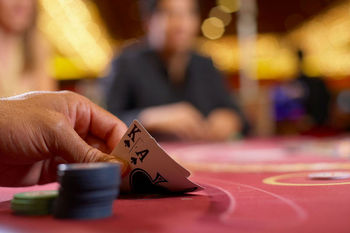 Baccarat
History - FROM MEDIEVAL RITUAL TO GAMBLING GAME
Baccarat
History - FROM MEDIEVAL RITUAL TO GAMBLING GAME
The word baccarat is Italian for "zero" and that's kind of where the story begins. "Zero" is important because of the fact that, as you'll see when you play the game or read the pages we have prepared on it, when any face card or ten-value card comes up it is not counted as ten (10) but a zero (0), although we don't know if that is really the root of it.
However, like every other game, it seems, the true genesis of it is a bit cloudy. The nation of origin may be France; it may be Italy. What is theorized is that baccarat is the result of a pagan ritual in which a decision was made as to whether a blond virgin would become a priestess. The stakes in this game were pretty high, as the virgin would throw a die to determine here own fate. If she rolled an eight or a nine, she would in fact move on to become a priestess at the temple. That was a good thing. If she rolled a six (6) or seven (7), it was a bad thing, because she would be banned from all religious activities from that point on. That was still better than the third alternative. If she rolled a six or lower, she was more or less sentenced to death compelled to walk straight into the ocean and drown herself, presumably.
Those are some very high stakes indeed.
Felix Falguierein is certainly one figures who was very prominent in the development of baccarat as a game. We go back to 1480 for this, by some accounts. Falguierein, an Italian, allegedly was a gambler and employed tarot cards in the early versions of the game.
One version of the story is that the game did indeed originate in Italy, with Falguierein, then spread over to France, where the French, as they did with the game of craps, changed the name, in what was undoubtedly their own way of "branding" it for themselves. So "bacara" became "Baccarat en Banque" and then "Chemin de Fer." It took on that name because it means "way of iron" and in France, the cards were placed in an iron box from which they were dealt.
This became an immensely popular game among France's upper crust, and fed into the image many people have about the game to this day. In Chemin de Fer the game was not banked by the casino itself but by the players, and the deal passed from one to the other. The casino operated by taking a rake from the winning that were accumulated in the game. In Baccarat en Banque and Chemin de Fer there is actually an element of skill that can be employed by players, which bring a different dimension from the game as it is played in the U.S.
From there it was on to the rest of Europe, starting with England, and finally on to America, and almost everywhere the game went it took on both subtle and/or fundamental changes, all of which had the effect of making it a game of true international intrigue.